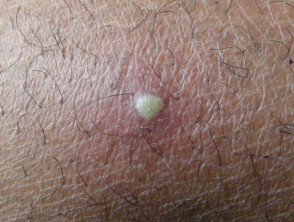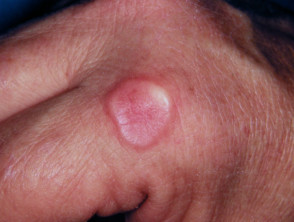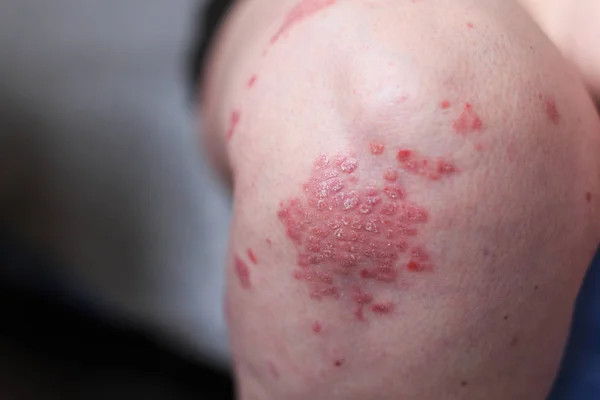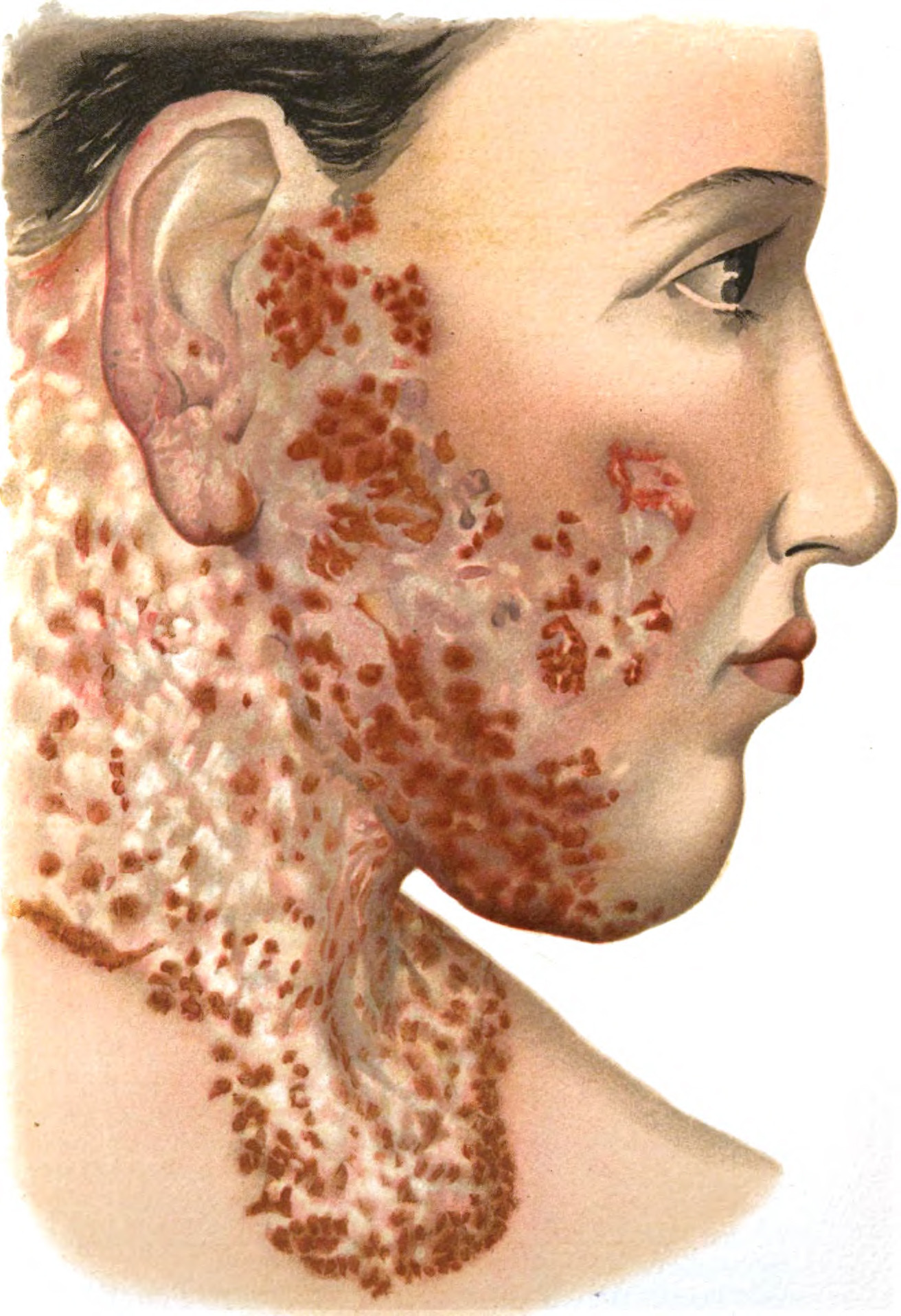Definisi
Furunkel merupakan penumpukan nanah pada jaringan kulit yang disebabkan oleh infeksi bakteri staphylococcus dan melibatkan folikel rambut (pori tempat tumbuhnya rambut) dan jaringan di sekitarnya. Furunkel berbeda dengan karbunkel. Karbunkel adalah gabungan dari beberapa furunkel. Furunkel dapat terjadi pada beberapa bagian tubuh, seperti leher, dada, wajah, dan bokong.
Penyakit ini dapat menyebabkan sensasi rasa nyeri yang cukup menyakitkan dan menyebabkan penderitanya merasa tidak nyaman, terutama bila terjadi pada bagian tubuh yang rentan mengalami iritasi, gesekan, atau tekanan seperti ketiak, bokong, punggung, leher, dan wajah. Furunkel sering terlihat sebagai benjolan kecil yang berisi nanah.
Penyebab
Furunkel terjadi karena infeksi yang disebabkan bakteri Staphilococcus aureus. Infeksi bakteri tersebut melibatkan bagian bawah rambut dan jaringan di sekitarnya. Bakteri ini sering ditemukan pada bagian tubuh yang lembap dan mudah teriritasi, seperti ketiak, bokong, punggung, leher, dan wajah.
Bakteri Staphilococcus aureus dapat menyebabkan infeksi pada:
- Kulit yang kering
- Kulit yang terluka akibat goresan, garukan atau gesekan
Ketika bakteri menyerang kulit dan terjadi proses infeksi, maka sistem kekebalan tubuh akan berusaha mengeliminasi bakteri tersebut sehingga terjadi proses terbentuknya nanah. Nanah kemudian dapat mengalami penumpukan pada lapisan kulit dan terbentuklah kantung berisi nanah yang terasa nyeri (abses).
Faktor Risiko
Umumnya furunkel dapat terjadi pada semua kelompok usia tanpa memandang jenis kelamin. Namun, terdapat beberapa faktor yang secara spesifik dapat meningkatkan risiko terjadinya kasus furunkel, yaitu:
- Memiliki gangguan sistem kekebalan tubuh
- Memiliki kondisi medis tertentu yang dapat memperlambat proses penyembuhan luka
- Mengalami penyakit kulit dalam jangka panjang (kronis)
- Obesitas
- Diabetes
- Tinggal di lingkungan padat penduduk
- Rumah atau lingkungan memiliki tingkat kebersihan yang kurang
- Berkontak erat dengan orang lain yang telah terinfeksi bakteri Staphylococcus aureus atau mengalami furunkel
- Lansia
Gejala
Pada furunkel, dapat ditemukan benjolan pada kulit yang berukuran kecil. Benjolan ini akan membesar seiring berjalannya waktu, dan ketika membesar akan terbentuk benjolan berwarna kemerahan. Benjolan tersebut dapat melunak karena lambat laun bisa terisi kumpulan nanah. Kulit yang kering dapat menjadi gejala awal yang patut diwaspadai karena dapat memudahkan proses perkembangan bakteri penyebab infeksi.
Biasanya, benjolan dapat terasa nyeri atau sakit. Gejala lain seperti rambut mudah rontok bisa timbul karena adanya proses peradangan dan kumpulan nanah pada kulit, sehingga rambut menjadi mudah tercabut atau rontok.
Diagnosis
Dokter akan cukup mudah mengenali penyakit ini dengan melihat gambaran kelainan yang muncul pada kulit Anda. Dokter akan bertanya mengenai keluhan kulit yang dirasakan, bagaimana kebiasaan Anda sehari-hari, bila ada faktor risiko yang dapat memperburuk kondisi penyakit, serta obat-obatan apa saja yang sudah Anda gunakan sebelumnya.
Namun, terkadang dokter juga bisa mengambil sampel kulit Anda untuk dikirimkan ke laboratorium. Di laboratorium, sampel kulit Anda akan diperiksa lebih lanjut di bawah mikroskop. Hal ini sangat berguna terutama pada pasien yang mengalami infeksi berulang, atau pasien yang tidak mengalami perbaikan walaupun telah mendapat terapi yang adekuat. Pemeriksaan ini disebut sebagai pemeriksaan biopsi.
Pada pasien yang mengalami infeksi berulang dengan proses penyembuhan yang lambat, dapat dilakukan pemeriksaan laboratorium lebih lanjut untuk melihat resistensi kuman penyebab furunkel terhadap obat antibiotik yang digunakan. Pemeriksaan ini penting agar dokter Anda dapat memberikan resep obat yang sesuai sehingga meningkatkan efek terapi dan mempercepat kesembuhan pasien serta mengurangi risiko infeksi berulang.
Tata Laksana
Umumnya, Anda dapat melakukan kompres hangat pada kulit yang mengalami infeksi dan peradangan. Kompres hangat ini bertujuan untuk mengurangi rasa nyeri dan memperlancar pengeluaran nanah dalam kulit, sehingga bengkak dapat berkurang. Pada kulit dengan penumpukan nanah yang cukup besar, dokter bisa melakukan prosedur pengeluaran nanah dengan menyayat area benjolan.
Pada infeksi yang cukup dalam, umumnya nanah tidak dapat dikeluarkan seluruhnya. Pada kondisi ini, dokter akan memasukkan kain kasa steril agar nanah dapat dikeluarkan secara maksimal. Bila nanah tidak dikeluarkan dengan maksimal dapat menyebabkan risiko infeksi berulang pada pasien, sehingga benjolan yang berisi nanah harus dipastikan sudah benar-benar bersih.
Dokter juga akan meresepkan obat antibiotik untuk melawan infeksi bakteri. Antibiotik yang diberikan bisa diberikan dalam bentuk obat oles seperti krim atau salep, dan obat tablet minum. Obat antibiotik minum umumnya diresepkan dokter bila terdapat banyak benjolan, ukuran benjolan besar, infeksi berulang, dan kondisi lainnya.
Komplikasi
Walaupun jarang ditemukan, bakteri penyebab furunkel dapat masuk ke dalam sistem peredaran darah dan berpindah ke organ tubuh lain. Infeksi ini berbahaya karena dapat menyebabkan infeksi lebih luas pada tubuh dan menyebar ke organ seperti jantung (endokarditis) dan tulang (osteomyelitis).
Komplikasi furunkel lainnya adalah infeksi Staphilococcus aureus resisten-metisilin (MRSA). Kondisi ini terjadi dikarenakan bakteri menjadi resisten dan tidak bisa diobati dengan beberapa antibiotik. Infeksi ini cukup sulit untuk diobati dan membutuhkan antibiotik golongan tertentu untuk memberikan efek terapi yang maksimal dan adekuat.
Pencegahan
Anda dapat mencegah dan mengurangi risiko terinfeksi bakteri Staphylococcus aureus dengan meningkatkan kebersihan diri dan lingkungan. Apabila Anda mengalami furunkel, lakukan beberapa langkah berikut untuk mencegah agar infeksi tidak menyebar ke bagian tubuh lain:
- Sering cuci tangan dan hindari menyentuh benjolan kulit yang mengalami infeksi, agar infeksi tidak menyebar ke bagian tubuh lain
- Jaga agar lesi kulit yang terinfeksi tetap bersih atau dapat juga ditutup dengan kassa steril
- Sebaiknya hindari pemakaian bersama perlengkapan pribadi Anda seperti kain handuk, pakaian, atau alat pencukur rambut dengan orang lain
- Cuci perlengkapan pribadi Anda dengan air hangat untuk membantu membunuh bakteri
- Hindari kontak erat dengan orang lain yang menderita komplikasi seperti Staphilococcus aureus resisten-metisilin (MRSA)
Kapan Harus ke Dokter?
Furunkel yang muncul pada area wajah, terutama di area dekat mata dapat mengganggu pandangan Anda. Jika Anda mengalami hal ini, sebaiknya Anda tidak menyentuh secara berlebihan furunkel tersebut karena berisiko menyebarkan infeksi bakteri ke mata Anda.
Selain itu, Anda juga harus mempertimbangkan untuk berkonsultasi dengan dokter apabila furunkel yang Anda alami terasa sangat sakit dan disertai demam, serta tidak mengalami perbaikan dalam kurun waktu dua minggu atau lebih. Furunkel yang terjadi secara berulang kali meski telah dilakukan pengobatan juga perlu mendapatkan penanganan khusus. Hal ini karena dikhawatirkan telah terjadi resisten bakteri penyebab furunkel terhadap obat yang diberikan dalam pengobatan. Pemeriksaan lebih lanjut diperlukan untuk memastikan hal tersebut.
Mau tahu informasi seputar penyakit lainnya? Cek di sini, ya!
- dr Hanifa Rahma
Healthline. (2019). What to know about furuncles (boils), diakses pada 28 March 2022 dari Furuncle: Causes, Symptoms, and Treatments (healthline.com)
Mayoclinic. (2021). Boils and Carbuncles, diakses pada 27 March 2022 dari Boils and carbuncles - Symptoms and causes - Mayo Clinic
Mayoclinic. (2021). Boils and Carbuncles: Diagnosis and Treatment, diakses pada 27 March 2022 dari Boils and carbuncles - Diagnosis and treatment - Mayo Clinic
MSDManual. (2021). Furuncles and Carbuncles, diakses pada 28 March 2022 dari Furuncles and Carbuncles - Dermatologic Disorders - MSD Manual Professional Edition (msdmanuals.com)
Medscape. (2021). Staphylococcus aureus infection clinical presentation, diakses pada 28 March 2022 dari Staphylococcus Aureus Infection Clinical Presentation: History, Physical, Causes (medscape.com)












